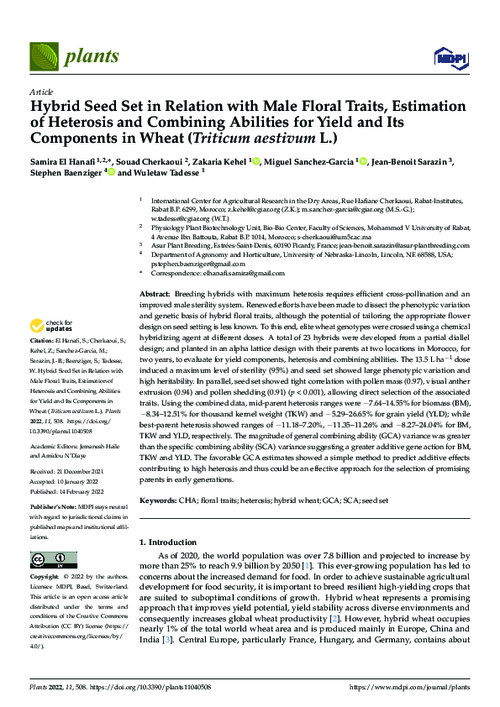Hybrid Seed Set in Relation with Male Floral Traits, Estimation of Heterosis and Combining Abilities for Yield and Its Components in Wheat (Triticum aestivum L.)
Abstract
Breeding hybrids with maximum heterosis requires efficient cross-pollination and an
improved male sterility system. Renewed efforts have been made to dissect the phenotypic variation
and genetic basis of hybrid floral traits, although the potential of tailoring the appropriate flower
design on seed setting is less known. To this end, elite wheat genotypes were crossed using a chemical
hybridizing agent at different doses. A total of 23 hybrids were developed from a partial diallel
design; and planted in an alpha lattice design with their parents at two locations in Morocco, for
two years, to evaluate for yield components, heterosis and combining abilities. The 13.5 L ha?1 dose
induced a maximum level of sterility (95%) and seed set showed large phenotypic variation and
high heritability. In parallel, seed set showed tight correlation with pollen mass (0.97), visual anther
extrusion (0.94) and pollen shedding (0.91) (p < 0.001), allowing direct selection of the associated
traits. Using the combined data, mid-parent heterosis ranges were ?7.64–14.55% for biomass (BM),
?8.34–12.51% for thousand kernel weight (TKW) and ?5.29–26.65% for grain yield (YLD); while
best-parent heterosis showed ranges of ?11.18–7.20%, ?11.35–11.26% and ?8.27–24.04% for BM,
TKW and YLD, respectively. The magnitude of general combining ability (GCA) variance was greater
than the specific combining ability (SCA) variance suggesting a greater additive gene action for BM,
TKW and YLD. The favorable GCA estimates showed a simple method to predict additive effects
contributing to high heterosis and thus could be an effective approach for the selection of promising
parents in early generations

